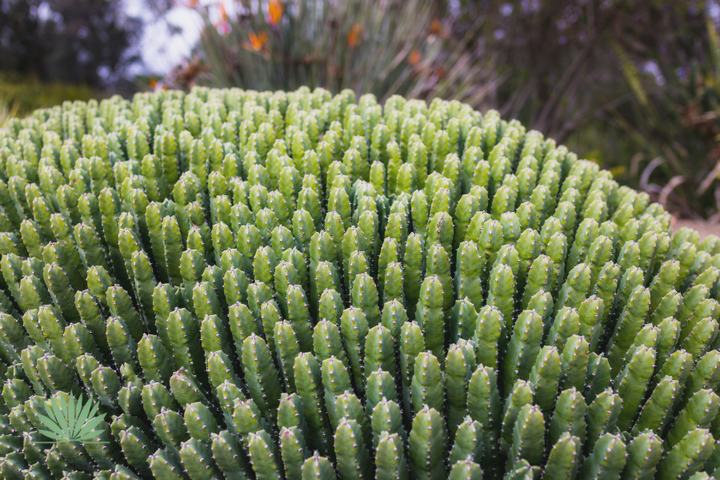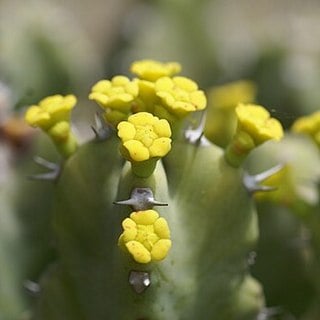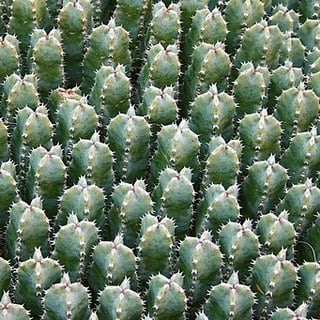Many succulents grow symmetrically, but Moroccan mound stands out as one of the most perfectly symmetric succulents you’ll ever grow. (But beware of its particularly noxious sap.) Here’s everything you need to know about growing this stunning Moroccan native in this complete care guide.

Moroccan mound (Euphorbia resinifera) is an eye-catching, low-growing succulent that’s comprised of a multitude of erect, tightly-packed stems that create a pleasing mounding effect.
Its photosynthetic stems have four sides and are nearly square. They range from blue-green to yellow-green and are lined with short but sharp spines.
One of its common names is staghorn coral, and you can see why. I can almost imagine this as an underwater plant growing in an aquarium or coral reef.
Moroccan mound is an extremely low-maintenance plant that makes a perfect addition to rock gardens or berms, or alongside boulders.
Moroccan mound rarely blooms when grown outside its native range. If conditions are right, it may flower once every few years. Its small bright yellow flowers line the stems’ ridges.

Since Moroccan mound’s sap is toxic and highly irritating, deer, rabbits, and javelinas leave it alone.
Why I Like This Plant
- Unusually symmetric
- Adds architectural interest all year long
- Extremely low maintenance, no pruning, litter-free
- Critter resistant
Things to Watch Out For
Like all members of the Euphorbia genus, Moroccan mound exudes milky sap that is toxic to ingest and irritating to skin and eyes. However, Moroccan mound’s sap is particularly dangerous. I was taken aback when I read in the Arizona State University’s plant library that it contains “some of the most potent irritants known.”
⚠️ Important warning! ⚠️
Moroccan mound’s sap is extremely irritating.
If you get any in your mouth or eyes,
consider it a medical emergency.
Optimal Growing Conditions
If you’re thinking of adding a Moroccan mound to your garden, you need to find a suitable place that will keep your plant healthy and looking good.
Here are the key factors to keep in mind.
Temperature
Moroccan mound should be grown in USDA Hardiness Zones 9 – 11. It’s cold-hardy down to 20℉.
It’s generally considered heat-loving, but the past few summers have pushed them to the limit. Some gardeners report theirs have succumbed to the heat. So don’t plant this in the hottest spot in your yard.
Sun Exposure
Moroccan mound likes full or part sun but should not be planted where it receives reflected heat. Plants appreciate some afternoon shade, which helps keep them blue-green. In all-day full sun, they’ll turn more yellow.
Size and Growth Rate
Moroccan mound is a slow grower. It sends up new stems around the perimeter, forming amazingly symmetric mounds that ultimately reach a size of 2 feet tall by 4 to 5 feet across.

Soil
Moroccan mound grows in any native desert soil type — sand, rocky, or clay — provided it’s well-draining.
Other Location Considerations
Moroccan mound should be kept away from curious kids and pets.
Since one misstep will ruin it’s beautiful symmetry, don’t plant it where it’s likely to get walked on by pedestrians, landscapers, or wildlife. Javelinas won’t eat it, but they’ll trample plants that are in their way.
Moroccan mound makes a stunning container plant, and works especially well in a low, bowl-shaped planter. Make sure your pot has drainage holes and use specifically formulated cactus soil.
Moroccan Mound:
The Essentials
| Common Name | Moroccan mound |
| Scientific Name | Euphorbia resinifera |
| Origin | Morocco |
| Plant Type | Succulent |
| USDA Zones | Zones 9 – 11 |
| Cold Hardiness | To 20℉ |
| Flower Color | Yellow |
| Flower Season | Late winter, spring |
| Mature Size | 2′ high x 4’ wide |
| Growth Rate | Slow |
| Sun Tolerance | Full, part sun |
| Water Needs | Low |
| Pests & Diseases | Root rot |
| Toxicity | Toxic, skin irritant |
| Wildlife | Critter resistant |
How to Plant
Dig a hole as deep as and twice as wide as the nursery container. Carefully remove the plant from the container, put it in the hole, and press the soil to remove any air pockets.
It’s generally recommended that you backfill with only native soil and not add any amendments. However, good drainage is critical. So if you know your soil is slow draining, amend with coarse sand or small gravel until you have a loose, well-drained mix.
When handling Moroccan mound, wear gloves. I put a pair of inexpensive disposable gloves over my regular gardening gloves and then toss when done. If you get sap on your gardening tools, clean them thoroughly before putting them away.
When to Plant
The best time to plant succulents is in April or May when warm soil temperatures encourage root development.
How to Care for Moroccan Mound
Whether you’ve recently planted a new Moroccan mound or have an existing one in your yard, here’s how to take care of it to keep it healthy and looking its best.
How to Water
You’re probably used to giving a plant a good soaking immediately after transplanting, but that isn’t the best practice with desert succulents like Moroccan mound.
The Arizona-Sonora Desert Museum advises not to water succulents for one to two weeks after planting. Then use the following schedule as a guide.
| Spring & Fall | Every 3-5 weeks |
| Summer | Every 2-4 weeks |
| Winter | Only if no winter rains |
Once established, Moroccan mound needs very little water. Overwatering can lead to root rot.
No supplemental water is necessary during the winter, provided there have been winter rains. And avoid watering if freezing temperatures are in the forecast.
If you’re growing one in a container, use this watering schedule as a guide.
| Spring & Fall | Every 7-10 days |
| Summer | Every 5-7 days |
| Winter | Every 10-14 days |
Should You Fertilize?
There is no need to fertilize a Moroccan mound planted in the ground. But if you grow one in a pot, fertilize lightly a few times a year when it’s actively growing.
Pruning & Propagation
Fortunately, pruning is rarely, if ever, necessary. The only time you may want to prune is to remove any damaged stems.
You can also prune a few stems if you want to use them to propagate new plants. Simply let the cut ends dry in the shade for a week or so, then stick them into cactus soil and water infrequently.
Plant Lover Facts
Moroccan mound goes by many common names including resin spurge, African spurge, officinal spurge, and staghorn coral.
It’s native to mountain regions of Morocco. The only place it has naturalized is in Spain.
It’s one of the earliest documented medicinal plants. It’s been used as a purgative, emetic, and treatment for snakebite for at least 2,000 years.
Moroccan mound contains high concentrations of resiniferatoxin, an analog of capsaicin, the compound that gives hot peppers their heat. Resiniferatoxin has a score of 16 billion Scoville heat units, which means it’s about 500 to 1000 times hotter than pure capsaicin! 🌶️🌶️🌶️
According to the Handbook of 200 Medicinal Plants, “Men who collect it have to cover their faces to prevent the dust entering their mouths, as it would cause all their teeth to fall out.”
Did you enjoy this article?
Sign up for our weekly newsletter
where you’ll find more great info on creating &
maintaining a beautiful, carefree desert landscape.
Author Bio
Deane Alban is the creator of Southwest Gardener. She is a science writer with a bachelor’s degree in botany from the University of South Florida. Gardening is her lifelong passion. She’s been gardening in Tucson for over 15 years.

Photo Credits
Ettrig, CC BY-SA 4.0, via Wikimedia Commons
Frank Vincentz, CC BY-SA 3.0, via Wikimedia Commons
